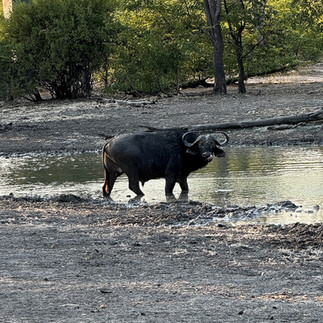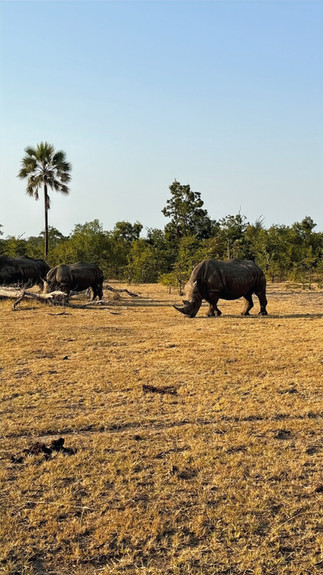Zambia Walking Safari in Mosi-oa-Tunya National Park
- Esther Mehesz

- Jun 8, 2024
- 6 min read
Updated: Jun 4
What is a Walking Safari in Zambia?
Hi friend!
Let's address the main question. When you think of an African safari, you probably picture open-air jeeps bouncing along dusty roads in search of lions or elephants. But in Zambia — the birthplace of walking safaris — there’s a quieter, more intimate way to experience the wild.
A walking safari is exactly what it sounds like: you leave the vehicle behind and explore the bush on foot, guided by expert trackers and armed rangers. It’s not about chasing the Big Five at high speed — it’s about slowing down, learning to read animal tracks, listening to the sounds of the bush, and observing wildlife in its natural habitat, often from a safe but thrillingly close distance. And trust me, there's nothing quite like seeing a rhino or giraffe when you're standing on the same ground, eye to eye with the wild. On our recent trip, we traded wheels during the middle of the safari for some walking in Mosi-oa-Tunya National Park, and it turned out to be a very rewarding morning of our time in Livingstone.
The Safari Begins
We were picked up at 6:30 AM from the Radisson Blu Hotel in Livingstone, and as we pulled out of the driveway, we were instantly greeted by… elephants. I think we can easily say that elephants are one of my favorites, and seeing them out in the open roaming by the hotel is a sight to see! Just casually grazing on the hotel grounds. If that’s not a good safari omen, I don’t know what is.
The early morning start meant cool air, clear skies, and a beautiful sunrise! But heads up: it's cold in the open jeep, especially between 6:30–7:30 AM. Layer up — you’ll thank yourself later when you start peeling them off around 9 once the sun comes up.
Small Park, Big Sightings
This was our first Zambian safari after visiting Chobe National Park in Botswana. And while Mosi-oa-Tunya is much smaller, this Zambia safari felt much more intimate and somehow richer.
Within minutes, we spotted:
Crawshay’s zebra (which we didn’t see in Chobe at all)
Several giraffes meander through the bush
Water buffalo, calmly gathering around the water sources inside the national park
Within a little time:
Endangered Rhinos during the guided walking safaris
What made it even more special was how quickly and effortlessly we spotted the diverse wildlife, as the safari guide knew the best spots for the diverse wildlife and always had their walkie-talkies to communicate with the other guides too. Unlike the vast drives we had in Chobe, here in Mosi-oa-Tunya, the wildlife felt closer, the park quieter, and the entire experience more immediate as they roamed in their natural habitat. It was refreshing to see a different mix of animals too—Chobe had its elephants and lions, but this smaller park was the best place for Crawshay’s zebras, more giraffes, and a peaceful calm that allowed us to appreciate every sighting without rushing. It was a different kind of safari—it was the best time for a slower, more personal, and honestly, a perfect contrast to the intensity of Chobe.
Later, we learned that just a few days earlier, there had been a fatal hippo incident involving tourists also in Zambia. I can only begin to imagine the fear and pain someone must have felt living through a traumatic encounter like that, and I feel deeply empathetic toward anyone who has. These are incredibly powerful animals in their natural environment — and while guides do their absolute best to keep us safe, it’s important to remember that we’re stepping into their world. This is still the wild with wild animals, and there’s always an element of risk, and it’s one we choose when we venture out into the wild.
Then there was the moment in Chobe when an elephant made it very clear it wasn’t happy. Ears flared, vocalizing loudly, and staring us down — we were in a small boat, just feet away. No chance to run, no shore to swim to. The energy shifted instantly, and my heart was pounding harder than I even realized. In those moments, you're reminded: there are no guarantees out here. It’s thrilling, raw, and just a little terrifying — the wild doesn’t come with seat belts.
Up Close with White Rhinos: The Walking Safari Begins
After the jeep portion, we met our walking guide and park rangers, rifles slung over their shoulders. But these rifles aren’t for the animals — they’re for protecting rhinos from poachers. At one point the park rangers even said, "Guns are for killing people, not for animals". These rangers will honestly do just about anything to protect these final remaining white rhinos and their tusks.
Escorted by the best guides, we followed animal tracks through the bush and soon found ourselves quietly approaching a small group of white rhinos, peacefully grazing in the morning light. It was humbling. Walking safaris are different — no engine, no distance buffer, just you, your guide, and the sounds of the bush. Every snapped twig feels louder. Every movement, closer. And sometimes you're questioning your life choices of whether or not you should seriously be this close to a wild endangered animal. But the views and the thrill of it are worth it!
Tips for Your Walking Safari in Zambia
Dress in layers - It’s cold early, but warms up quickly. I could have easily used an extra layer in the morning, but there were blankets in the safari, which were helpful to staying warm in that first hour or two.
Wear closed, comfortable shoes for uneven terrain, and just to make it easier to get in and out of the jeep.
If you have room, bring binoculars and a camera strap — you’ll want your hands free.
You don't have to have the fanciest camera equipment. At first, I was a little intimidated when I saw other tourists with their big cameras, but honestly, remember the true reason that you are there. Are you there to experience for yourself? Capture the moment for your brain and memory. Don't forget to live in the moment during these safaris! Definitely get pictures, but if it's on your phone, that's ok too! Phones nowadays have some decently good cameras!
Go early - The dry season mornings are when animals are most active.
Ask questions - The guides are a wealth of knowledge on bird life, wildlife, and conservation efforts, and they are more than happy to share with you everything that they know!
Bring a portable charger - yes, you don't have to capture every little movement on photo or video, but you will want to get a fairly good amount, and there's nothing worse than a phone battery or a camera battery dying in the middle of a safari. Highly recommend bringing one that you don't need extra cords for, like this one.
Why This Safari Was Different
This wasn’t a multi-day trek through South Luangwa National Park or Lower Zambezi, but it was:
Easy access from Livingstone makes it an ideal location for a safari near the hotel
Had a mix of open-air jeep safari and a short walk that still delivered rich wildlife viewing
A perfect pairing with a visit to Victoria Falls that same day, later in the afternoon
Quiet, uncrowded, and deeply immersive
And best of all? We made it back to the Radisson Blu by 10:15 AM, just in time to catch the tail end of breakfast. A couple of hours was all it took for an unforgettable Zambian walking safari.
Final Thoughts
If you're heading to Southern Africa, especially around Victoria Falls, don’t skip this. While the Luangwa Valley and Kafue National Park are famous for their mobile walking safaris and big cats, Mosi-oa-Tunya is proof that you don’t need to go remote to have an authentic walking safari experience. Whether you're a first-timer or a seasoned safari traveler, walking in Zambia’s national parks offers a perspective few other safari destinations can match.
Still can’t believe we walked with rhinos. Not sure how the next adventure can top that one! I'll be sitting around like this baboon thinking about what I just saw! Till next time!





















Comments